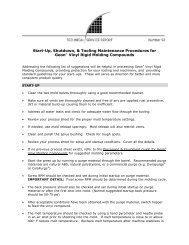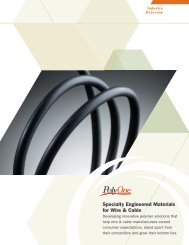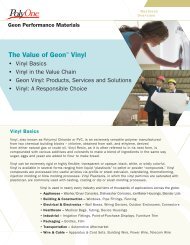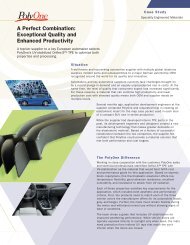PolyOne 2009 Annual Report
PolyOne 2009 Annual Report
PolyOne 2009 Annual Report
You also want an ePaper? Increase the reach of your titles
YUMPU automatically turns print PDFs into web optimized ePapers that Google loves.
POLYONE CORPORATION<br />
buyer or similar specific transactions, we believe that the use of<br />
these two methods provides reasonable estimates of the reporting<br />
units’ fair value and that these estimates are consistent with how<br />
we believe a market participant would view the fair value of each of<br />
the reporting units. Estimates of fair value using these methods<br />
reflects a number of factors, including projected future operating<br />
results and business plans, economic projections, anticipated<br />
future cash flows, comparable marketplace data within a consistent<br />
industry grouping and the cost of capital. There are inherent uncertainties,<br />
however, related to these factors and to management’s<br />
judgment in applying them to this analysis. Nonetheless, management<br />
believes that the combination of these two methods provides<br />
a reasonable approach to estimate the fair value of our reporting<br />
units.<br />
The market approach is used to estimate fair value by applying<br />
sales and earnings multiples (derived from comparable publiclytraded<br />
companies with similar investment characteristics of the<br />
reporting unit) to the reporting unit’s operating performance<br />
adjusted for non-recurring items. Management believes that this<br />
approach is appropriate as it provides an estimate of fair value<br />
reflecting multiples associated with entities with operations and<br />
economic characteristics comparable to our reporting units. The key<br />
estimates and assumptions that are used to determine fair value<br />
under this approach include trailing twelve-month earnings before<br />
interest, taxes, depreciation and amortization (EBITDA) and projected<br />
EBITDA based on consensus estimates as reported by a<br />
third-party resource, which would approximate a market participant’s<br />
view, to determine the market multiples to calculate the<br />
enterprise value.<br />
The income approach is based on projected future debt-free<br />
cash flows discounted to present value using factors that consider<br />
the timing and risk of the future cash flows. Management believes<br />
that this approach is appropriate because it provides a fair value<br />
estimate based upon the reporting unit’s expected long-term operating<br />
and cash flow performance. This approach also mitigates the<br />
impact of cyclical downturns that occur in the reporting unit’s<br />
industry. The income approach is based on a reporting unit’s projection<br />
of operating results and cash flows discounted to present<br />
value using a weighted-average cost of capital. The projection is<br />
based upon management’s best estimates of projected economic<br />
and market conditions over the related period including growth<br />
rates, estimates of future expected changes in operating margins<br />
and cash expenditures. Other significant estimates and assumptions<br />
include terminal value growth rates, terminal value margin<br />
rates, future capital expenditures and changes in future working<br />
capital requirements based on management projections.<br />
Indefinite-lived intangible assets consist of a tradename,<br />
acquired as part of the January 2008 acquisition of GLS, which<br />
is tested annually for impairment. The fair value of the trade name is<br />
calculated using a “relief from royalty payments” methodology. This<br />
approach involves two steps (1) estimating reasonable royalty rates<br />
for the tradename and (2) applying this royalty rate to a net sales<br />
stream and discounting the resulting cash flows to determine fair<br />
value. This fair value is then compared with the carrying value of the<br />
tradename. Other finite-lived intangible assets, which consist primarily<br />
of non-contractual customer relationships, sales contracts,<br />
patents and technology, are amortized over their estimated useful<br />
lives. The remaining lives range up to 15 years.<br />
In accordance with the provisions of FASB ASC Topic 360,<br />
Property, Plant, and Equipment, we assess the fair value of our longlived<br />
assets on a non-recurring basis. In <strong>2009</strong>, we recorded impairment<br />
charges totaling approximately $8.6 million for certain of the<br />
facilities that were closed as a result of the previously mentioned<br />
plant phaseout activities. Our estimates of fair value are based<br />
primarily on estimates from broker opinions of value and appraisals<br />
of the assets. As these fair value measurements are based on<br />
significant unobservable inputs, such as recent sales of comparable<br />
properties, they are classified within Level 3 of the fair value<br />
hierarchy.<br />
Note 20 — BUSINESS COMBINATIONS<br />
Acquisition<br />
On December 23, <strong>2009</strong> we acquired substantially all of the<br />
assets of NEU, a specialty healthcare engineered materials provider,<br />
for a cash purchase price of $11.5 million paid at close and an<br />
earnout of up to $0.5 million payable in 2011, resulting in goodwill<br />
of $4.5 million and $5.9 million of identifiable intangible assets.<br />
NEU had sales of $7.7 million for the year ended December 31,<br />
2008. Our purchase price allocation is preliminary and may require<br />
subsequent adjustment.<br />
On January 2, 2008, we acquired 100% of the outstanding<br />
capital stock of GLS, a global provider of specialty TPE compounds<br />
for consumer, packaging and medical applications, for a cash purchase<br />
price of $148.9 million including acquisition costs, net of<br />
cash received. GLS, with sales of $128.8 million for the year ended<br />
December 31, 2007, has been fully integrated into the Specialty<br />
Engineered Materials segment. This acquisition complements our<br />
global engineered materials business portfolio and accelerates our<br />
shift to specialization. The combination of GLS’s specialized TPE<br />
offerings, compounding expertise and brand, along with our extensive<br />
global infrastructure and commercial presence offers customers:<br />
enhanced technologies; a broader range of products, services<br />
and solutions; and expanded access to specialized, high-growth<br />
markets around the globe. The combinations of these factors are<br />
the drivers behind the excess of the purchase price over the fair<br />
value of the tangible assets and liabilities acquired.<br />
Note 21 — SHAREHOLDERS’ EQUITY<br />
In August 2008, our Board of Directors approved a stock repurchase<br />
program authorizing us, depending upon market conditions<br />
and other factors, to repurchase up to 10.0 million shares of our<br />
common stock, in the open market or in privately negotiated<br />
transactions.<br />
During <strong>2009</strong>, no shares were repurchased under this program.<br />
During 2008, we repurchased 1.25 million shares of common stock<br />
under this program at an average price of $7.12 per common share<br />
60



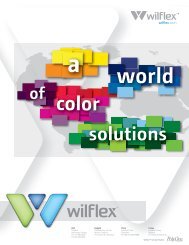
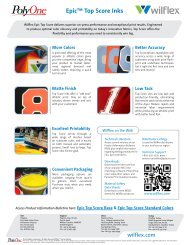
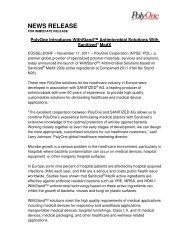

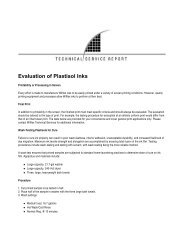
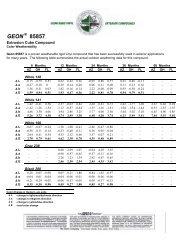
![TPE Injection Molding Guide [PDF] - GLS Thermoplastic Elastomers](https://img.yumpu.com/26329362/1/190x245/tpe-injection-molding-guide-pdf-gls-thermoplastic-elastomers.jpg?quality=85)
